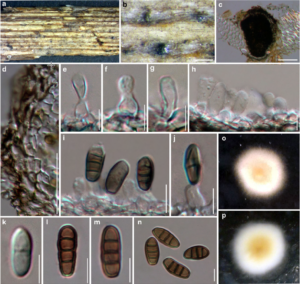Floricola viticola Phukhamsakda, Camporesi & K.D.Hyde.
Index Fungorum number: IF551366; Facesoffungi number: FoF00896; Fig. 1
Etymology – named after the host genus, Vitis.
Holotype – MFLU 15–1404
Saprobic on dead branch of Vitis vinifera L. Sexual morph: Undetermined. Asexual morph: Conidiomata 220 – 239 μm high × 154 – 202 μm (x̄ = 237 × 177 μm, n = 10) diam., solitary, pycnidial, unilocular, scattered, immersed to erumpent, subglobose, dark brown to black. Pycnidial wall 13 – 35μm (−40μm at apex), externally merging with host tissues, composed of brown cells of textura angularis with a hyaline inner lining bearing conidiogenous cells. Conidiophores reduced to conidiogenous cells . Conidiogenous cells 2 – 10 × 2 – 9 μm (x̄ = 4 × 5 μm, n = 20) diam., enteroblastic, phialidic, determinate, solitary, doliform, smooth-walled, hyaline. Conidia 7 – 12 × 2 – 6 μm (x̄ = 9 × 4 μm, n = 50), initially hyaline, dark brown at maturity, oblong, subfusiform, occasionally curved at the apex, with slight abscission scar at base of conidia, with 1 – 3 longitudinal septa, constricted at some septa, narrowly rounded at both ends, smooth – walled.
Cultural characteristics – Colonies on PDA reaching 20 mm diam. after 4 weeks at 16 °C, cream to orangishwhite at the margins; reverse white to cream and orangish white at the center, medium dense, circular, umbonate, fimbriate, fluffy, slightly radiating in the lower part, without diffusible pigments.
Material examined – ITALY, Forlì-Cesena Province, near Galeata, on dead branch of Vitis vinifera (Vitaceae). 16 October 2014, E. Camporesi (MFLU 15–1404, holotype), (isotype in HKAS, under the code of HKAS88971), ex-type living culture, MFLUCC 15–0039.

Fig. 1 Floricola viticola (holotype) a Habit of Floricola viticola on Vitis vinifera L. b Close up of conidiomata below surface of host c Vertical section through the conidioma d Part of conidiomata peridium e – j Developing state of conidiogenous cells k – n Conidia o – p Culture character on PDA. Scale bar: b = 200 μm, c = 100 μm, d = 50 μm, e – n = 5 μm.
